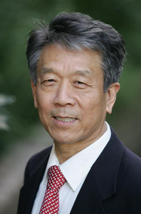 |
Institute for Superconducting & Electronic Materials
|
S.X. Dou
is an Australian Professorial Fellow and Director of the Institute for
Superconducting and Electronic Materials (ISEM) in University of
Wollongong. He received his PhD in chemistry in 1984 at Dalhousie
University, Canada. He was awarded a MM Chair of Superconductivity in
1989. He
was elected as a Fellow of the Australian Academy of Technological
Science and Engineering in 1994. He was awarded a DSc by the University
of New South Wales in 1998 and awarded three Australian Professorial
Fellowship by Australian Research Council from 1993-2012.
Australian Government awarded him the
Centenary Medal for his achievements in materials science and
engineering in 2003. He received Vice-Chancellor Excellent Senior
Researcher Award in 2008 and Outstanding Partnership award in 2012. His
publications have attracted more than 13200 citations with
h index of 52. He has supervised or
co-supervised 60 PhD graduates and more than 30 postdoc fellows.
Dou is specialised in energy and
electronic materials including high performance lithium ion battery for
electric vehicles and patented magnesium diboride superconductor wires
for applications in magnetic resonance imaging and electric power system
such as fault current limiter for smart grid and electric generator for
wind turbine.
Development of nano-materials for energy applications at Institute for Superconducting and Electronic Materials (ISEM)
The Institute for Superconducting and Electronic Materials (ISEM) has built an interdisciplinary research capability in advanced materials and technology for energy applications including batteries, supercapacitors for energy conversion and storage, thermoelectric, magnetocaloric, thermionic materials and fuel cells for waste energy recovery and energy generation, superconductors for energy transmission, storage and electrical devices. Wides pread adoption of electric vehicles (EVs) has immense potential for social, economic and environmental benefits. However, the major challenges that are impeding the widespread uptake of EV’s, including short driving range, difficulties to recharge, safety and high cost, must be addressed. Significant advances already made by our group include high capacity anodes using carbon coated nanoscale Si and nanowire SnO2, composite oxide/carbon nanotubes, and high capacity and high power cathodes using nanocomposites. The work on alloyed LiFePO4/C nanocomposite showed a fast charging rate within several minutes with long cycling stability over 1000 cycles. These advances represent important milestones in the development of high power and high energy density batteries and supercapacitors for electric vehicles. In superconductivity area, we have made a breakthrough in the fabrication of wires from the superconductor magnesium diboride by using nano-scale doping. They have achieved a world record high critical current carrying capacity in superconducting MgB2 wires and a record high upper critical field for the nano-scale SiC doped MgB2. This is one of the most important advances since the discovery of superconductivity in this material and has an important impact on the development of technological uperconductors. This emerging superconductor would have practical applications, such as wind turbine generators, magnetic resonance imaging (MRI), fault current limiters, power cables, motors, energy storages, generators, magnetic separators and transformers, and will lead to enormous energy and cost savings. There are 58% energy wasted in the form of heat, recovery of waste heat in steel and iron making companies and automotives is one of our research focuses. This goal will be achieved by developing thermoelectric generators. Our group has developed Al-containing ZnO nanocomposites with up to a factor of 20 lower thermal conductivity than non-nanostructured ZnO, while retaining bulk like electrical conductivity. The resultant figure of merit (ZT) at 1000 K is 50% higher than that for the best non-nanostructured counterpart material at the same temperature and holds promise for engineering advanced oxide-based high-ZT thermoelectrics for applications.